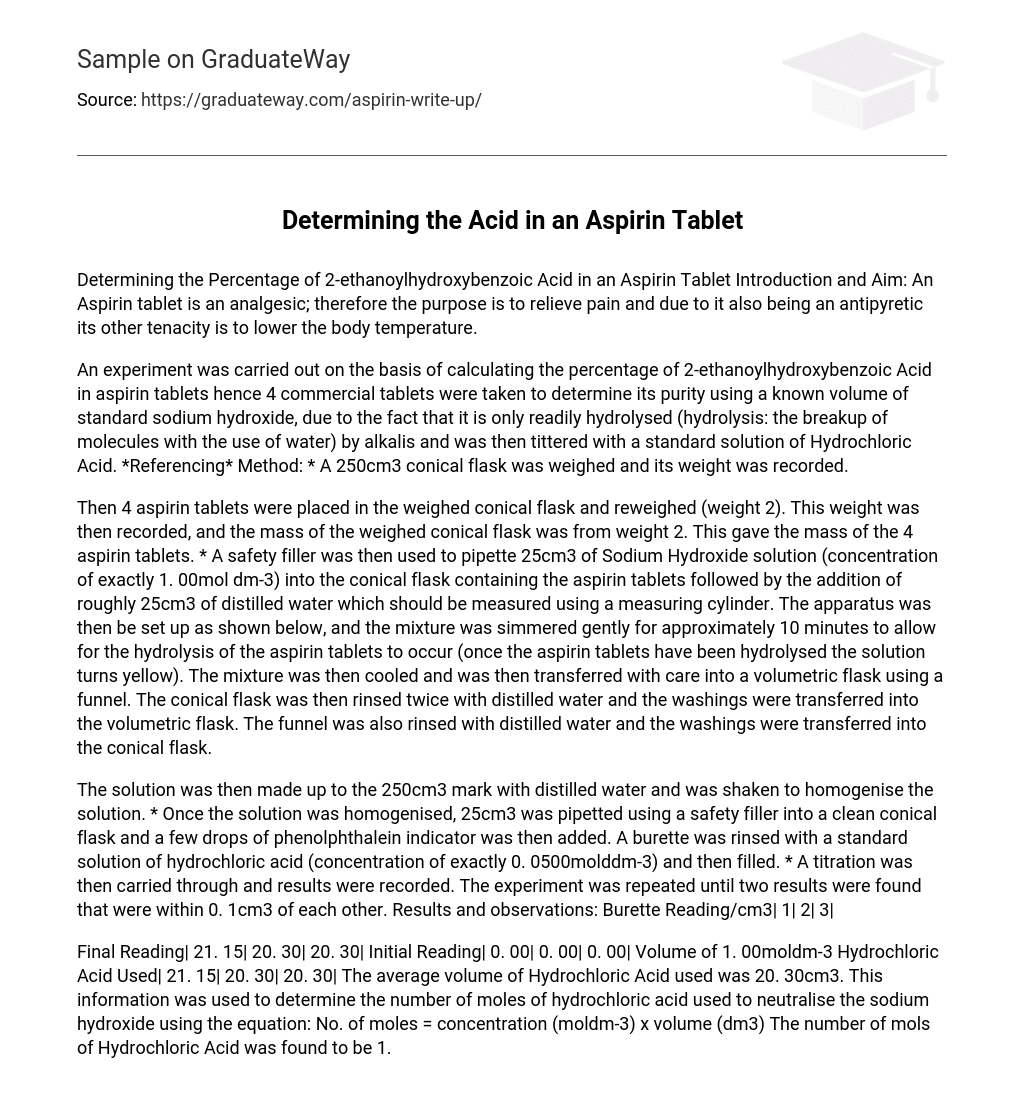Determining the Percentage of 2-ethanoylhydroxybenzoic Acid in an Aspirin Tablet Introduction and Aim: An Aspirin tablet is an analgesic; therefore the purpose is to relieve pain and due to it also being an antipyretic its other tenacity is to lower the body temperature.
An experiment was carried out on the basis of calculating the percentage of 2-ethanoylhydroxybenzoic Acid in aspirin tablets hence 4 commercial tablets were taken to determine its purity using a known volume of standard sodium hydroxide, due to the fact that it is only readily hydrolysed (hydrolysis: the breakup of molecules with the use of water) by alkalis and was then tittered with a standard solution of Hydrochloric Acid. *Referencing* Method: * A 250cm3 conical flask was weighed and its weight was recorded.
Then 4 aspirin tablets were placed in the weighed conical flask and reweighed (weight 2). This weight was then recorded, and the mass of the weighed conical flask was from weight 2. This gave the mass of the 4 aspirin tablets. * A safety filler was then used to pipette 25cm3 of Sodium Hydroxide solution (concentration of exactly 1. 00mol dm-3) into the conical flask containing the aspirin tablets followed by the addition of roughly 25cm3 of distilled water which should be measured using a measuring cylinder. The apparatus was then be set up as shown below, and the mixture was simmered gently for approximately 10 minutes to allow for the hydrolysis of the aspirin tablets to occur (once the aspirin tablets have been hydrolysed the solution turns yellow). The mixture was then cooled and was then transferred with care into a volumetric flask using a funnel. The conical flask was then rinsed twice with distilled water and the washings were transferred into the volumetric flask. The funnel was also rinsed with distilled water and the washings were transferred into the conical flask.
The solution was then made up to the 250cm3 mark with distilled water and was shaken to homogenise the solution. * Once the solution was homogenised, 25cm3 was pipetted using a safety filler into a clean conical flask and a few drops of phenolphthalein indicator was then added. A burette was rinsed with a standard solution of hydrochloric acid (concentration of exactly 0. 0500molddm-3) and then filled. * A titration was then carried through and results were recorded. The experiment was repeated until two results were found that were within 0. 1cm3 of each other. Results and observations: Burette Reading/cm3| 1| 2| 3|
Final Reading| 21. 15| 20. 30| 20. 30| Initial Reading| 0. 00| 0. 00| 0. 00| Volume of 1. 00moldm-3 Hydrochloric Acid Used| 21. 15| 20. 30| 20. 30| The average volume of Hydrochloric Acid used was 20. 30cm3. This information was used to determine the number of moles of hydrochloric acid used to neutralise the sodium hydroxide using the equation: No. of moles = concentration (moldm-3) x volume (dm3) The number of mols of Hydrochloric Acid was found to be 1. 015 x 10-3, and due to the fact that the hydrochloric acid and sodium hydroxide react in a 1:1 ratio, the moles of sodium hydroxide in 25cm3 was found to be the same.
In order to find the number of mols in 250cm3 the concentration found in 250cm3 was multiplied by 10, giving a result of a 0. 01015mols which then allowed for the number of moles used in the hydrolysis of the aspirin to be found by the following calculation: 0. 025 – 0. 01015 = 0. 01485mols The…… is in a 2:1 ratio hence the number of moles was divided by 2 hence giving the number of moles of aspirin This was then used to calculate the theoretical mass of the aspirin of the tablets used hence the equation mass=Mr×number of moles was used therefore determined that the theoretical mass was





